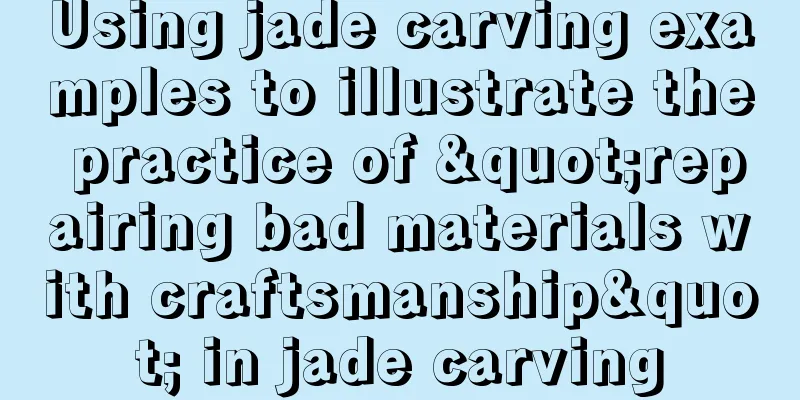Using jade carving examples to illustrate the practice of "repairing bad materials with craftsmanship" in jade carving

|
To evaluate the value of jade, we generally measure it from five aspects: type, water, base, color, and workmanship. The first four factors are the natural quality of jade, which fundamentally determine the value of jade. Craftsmanship refers to the acquired carving of jade, which is the ultimate way to enhance the value of jade. In high-end jade, the carving of jade has little impact on the overall value of the finished product, but in general jade, the carving of jade affects the value of the finished product, just as the popular saying in the jade carving circle says: "If the material is not good, the craftsmanship can save it." Just like the small material I want to share today, its shape is large in the middle and small on both sides. Under the light we can see that the water quality is just ordinary glutinous ice material, and the base is average. Its advantage is that it has no obvious flaws. Judging from the quality and shape of this material, it is suitable for making lucky melons, but there will not be much surprise when making lucky melons from this material, and the value of the finished product is also average! Because of this value situation, the jade carving master decided to try the idea of "if the material is not good, the craftsmanship can save it" to create this material. After weighing and analyzing, he finally composed the material into an octopus-themed pendant according to the shape of the jade: this composition arranges the octopus's big round head on the protruding part in the middle of the jade, and reasonably divides the octopus claws around it. The carving uses a combination of round carving and openwork carving to carve patterns, and the octopus's eight claws are carved through openwork. These hollow parts increase the ability of light to penetrate jade, improve the refraction of light, and play a role in regulating the water of the octopus, making the finished product more transparent and jade-like. On the back of the three-dimensional round sculpture, the line pattern echoes the front shape, and the copper coin designed at the bottom of the octopus serves as the "finishing touch" - the octopus is commonly called octopus, and in jade carving culture, "eight" is homophonic to "fa", and the octopus has eight claws, so the combination has the beautiful meaning of making a fortune! When we finally pick up the goods, we can see that although the natural water quality of the jade is average, through clever water adjustment techniques, it also has a faint sticky feeling. If you use jadeite with this kind of effect to carve a melon, it is destined to be a very ordinary jade pendant. But this carved octopus pendant, although not high-end jadeite, is definitely a very special masterpiece! fcgc66 fcpf18 |
<<: Revealing the secrets of hand-carved jadeite
Recommend
Like a landscape painting, the black-chicken jade is beautiful in a unique way, but many people mistake it for black jade.
When talking about black jade, everyone will thin...
What kind of jade is worth collecting?
What kind of jade has collection value? This is a...
Why does jade have such a high investment value?
Chinese people like jade. In the past, people car...
The finest jadeite collected by the Forbidden City is a feast for the eyes!
▲Jadeite bonsai from the Qing Dynasty Chinese peo...
Where does the value of blue water jadeite lie?
1. Rarity of materials As mentioned earlier, the ...
There is a reason why I like jadeite carved into Buddha shapes!
Looking at the jade market, it is not difficult t...
The perfect combination of jade and diamonds is the favorite of celebrities!
Jade and diamonds, the collision of Chinese and W...
Choosing jade ornaments in this way will bring you wealth!
So-called ornaments are things placed in public a...
When choosing jadeite, how can you make yourself look more knowledgeable?
I often come across some friends who are no ordin...
Sugong, Jieyanggong and Sihuigong are common jade crafts. What are the differences between them?
Friends who like jade may hear the owner introduc...
This is how you should choose jadeite to get the best value for money! Did you know
Jade and jadeite have been the favorites of the C...
A piece of blue water jadeite with a unique Buddha theme
Working in the jade business is really interestin...
Jade knowledge - Jade characteristics and the origin of jade
Jade is a rising star in the jewelry industry. Du...
Spring is the season of revival for all things. Here is the jade wearing guide for the elegant queen.
After the Waking of Insects, insects begin to mov...
The trend of high-end collectibles investment market, jewelry and jadeite account for more than one-third!
In a blink of an eye, half of 2021 has passed, an...









